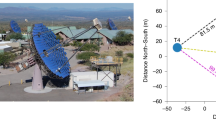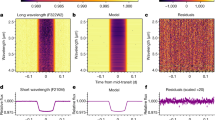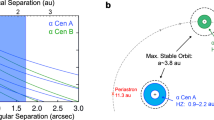Abstract
THE only known planets are the nine in our Solar System, so the origin of the Solar System and of stars in general would be clarified if other planetary systems could be discovered. Likewise, speculation about life in the Galaxy would benefit from knowing which stars have planets. Astrometry, radial velocity measurement, and direct photography from orbit might detect planets, but none of these approaches will be easy. Astrometry would require detection of the motion of a stellar image, relative to background stars, by ±0.5 arcms as 12 yr elapse (for a system identical to the Sun plus Jupiter but situated at a distance of 10 pc). Alternatively, a radial velocity change of ±12 m s−1 over the 12 yr would reveal a Jupiter-like planet which would mean detecting a spectral line shift of 2×10−4 line widths in a line 0.1 nm wide. The instruments required would need stability over a period of years as well as sensitivity. Direct photography from orbit would invoke precision apodisation and would require surface accuracies on optical surfaces of hitherto unattained quality. The new infrared method proposed here also needs to be considered.
This is a preview of subscription content, access via your institution
Access options
Subscribe to this journal
Receive 51 print issues and online access
$199.00 per year
only $3.90 per issue
Buy this article
- Purchase on SpringerLink
- Instant access to full article PDF
Prices may be subject to local taxes which are calculated during checkout
Similar content being viewed by others
References
Everitt, C. W. F. Final Rep. NASA Grant 05-020-019, Stanford Univ. (1977).
Witteborn, F. C. & Young, L. S. J. Spacecraft Rockets 13, 667 (1976).
Hedden, R. L. Proc. SPIE Symp Infrared Technology (1975, 1976) 95, 8 (1976).
Soifer, B. T., Houck, J. R. & Harwit, M. Astrophys. J. Lett. 168, L73 (1971).
Pipher, J. L., Houck, J. R., Jones, B. W. & Harwit, M. Nature 231, 375 (1971).
Author information
Authors and Affiliations
Rights and permissions
About this article
Cite this article
BRACEWELL, R. Detecting nonsolar planets by spinning infrared interferometer. Nature 274, 780–781 (1978). https://doi.org/10.1038/274780a0
Received:
Accepted:
Issue Date:
DOI: https://doi.org/10.1038/274780a0
This article is cited by
-
Scalable photonic-based nulling interferometry with the dispersed multi-baseline GLINT instrument
Nature Communications (2021)
-
Astrophotonics: astronomy and modern optics
The Astronomy and Astrophysics Review (2021)
-
The path towards high-contrast imaging with the VLTI: the Hi-5 project
Experimental Astronomy (2018)
-
Space-based infrared interferometry to study exoplanetary atmospheres
Experimental Astronomy (2018)



